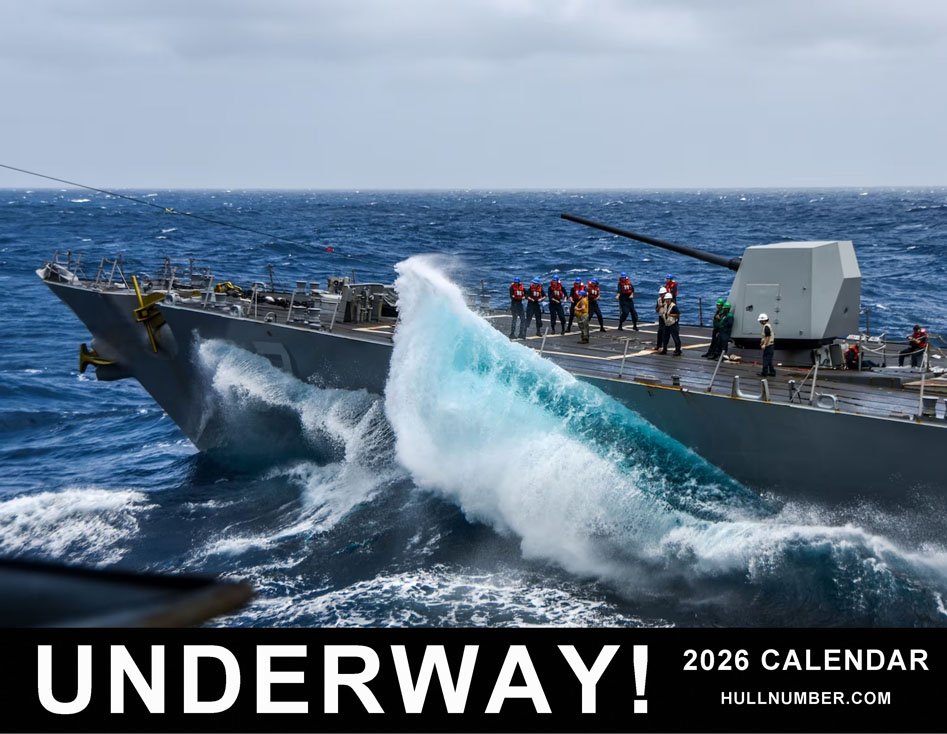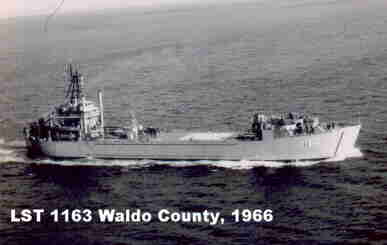 |
|||||||
| UNDERWAY! 2026 WALL CALENDAR is AVAILABLE - CLICK HERE |
|||||||
 |
|||||||
 |


U.S.S. WALDO COUNTY
(LST-1163)WILL DO
Click to view crew list
USS WALDO COUNTY (LST-1163 ) - a LST-1156 class landing ship tank
In Commission 1953 to 1970LST-1163 Deployments - Major Events
| Add a LST-1163 Shellback Initiation | Add a LST-1163 Deployment - Major Event | ||||
| Month | Year | to | Month | Year | Deployment / Event |
|---|---|---|---|---|---|
| MAY | 1941 | - | OCT | 1961 | Mediterranean |
| AUG | 1952 | - | Keel Date: 4 AUG 1952 at Ingalls Shipbuilding Pascagoula MS | ||
| MAY | 1953 | - | Launch Date: 17 MAY 1953 | ||
| SEP | 1953 | - | Commissioned: 17 SEP 1953 | ||
| JAN | 1955 | - | MAY | 1955 | Regular Overhaul |
| AUG | 1955 | - | JAN | 1956 | Mediterranean |
| SEP | 1957 | - | FEB | 1958 | Mediterranean |
| SEP | 1959 | - | Shellback Initiation - 10 SEP 1959 - Atlantic Ocean | ||
| APR | 1961 | - | OCT | 1961 | Mediterranean |
| FEB | 1962 | - | APR | 1963 | Cuban Missle Blockade |
| SEP | 1962 | - | FEB | 1963 | Cuban Missle Blockade |
| SEP | 1962 | - | FEB | 1963 | Mediterranean |
| SEP | 1962 | - | FEB | 1963 | Mediterranean |
| MAY | 1964 | - | NOV | 1964 | Mediterranean |
| MAY | 1965 | - | AUG | 1965 | Caribbean |
| AUG | 1967 | - | DEC | 1967 | Caribbean |
| AUG | 1968 | - | AUG | 1968 | puerto rico |
| DEC | 1970 | - | Decommissioned: 21 DEC 1970 | ||
LST-1163 General Specifications
Class: LST-1156 class landing ship tank
Named for: Waldo County in Maine
Complement: 16 Officers and 189 Enlisted
Displacement: 2440 tons
Length: 384 feet
Beam: 55 feet
Flank Speed: 14 knots
Final Disposition: Leased to Peru 7 August 1984Sold outright to Peru 26 April 1999
USS WALDO COUNTY (LST-1163)
Waldo
County (LST-1163)
was laid down in August 1952 at Pascagoula, Miss., by Ingalls Shipbuilding Corp. simply as LST-1163; launched
on St. Patrick's Day 1953;
sponsored by Mrs. C. Richard Shaeffner; and commissioned on 17 September 1953,
Lt. Comdr. Robert H. Steinkellner in command.
LST-1163
departed Pascagoula
on 14 October and steamed
via Key West, Port Everglades, and Charleston to her permanent home port, the amphibious base at Little Creek, Va. She arrived at
Little Creek on 25 October.
Exercises and shakedown training occupied the remainder of 1953 and the first few months of1954. On 14 June 1954, the tank landing
ship departed Little
Creek for Morehead City,
N.C., to embark marines for amphibious exercises. She arrived at Morehead City on the 15th,
loaded troops and equipment, and got underway
on the 16th for
Vieques Island located near Puerto Rico in the West Indies. The ship reached Vieques on 21 June and
conducted amphibious training
until 1 July when she headed back to Little Creek. She arrived at Little Creek
on 5 July and remained
there eight days before entering the Norfolk Naval Shipyard on 13 July. She
left the shipyard on 6
August and returned to Little Creek to resume duty with the Amphibious
Force, Atlantic Fleet. For the remainder of the year, LST-1163
conducted a series of amphibious exercises, mostly at Vieques in the West Indies, but she also participated
in one cold weather exercise
at Hamilton Inlet on the coast of Labrador in November.
On 18
January 1955, she entered the Philadelphia Naval Shipyard for her first major overhaul. She emerged from the yard,
revitalized, on 20 May and resumed duty with the Amphibious Force. On 1 July1955, LST-1163 became Waldo
County (LST-1163). Through the summer of 1955, Waldo County remained
close to or in Little Creek; however, on 24 August, she departed the Norfolk area for her
first overseas deployment.
After stops at Bordeaux in France, Port Lyautey in Morocco, and at Gibraltar, she joined the 6th
Fleet in the
Mediterranean late in September. For the next four months, she ranged the length and breadth of
the "middle
sea," conducting 6th Fleet amphibious exercises and making port visits. On
25 January 1956, she departed
Port Lyautey on her way home.
The ship returned
to Norfolk on 6 February and resumed operations with the 2d Fleet.
In her
first two years of active service, Waldo County established a pattern of
operations which endured
until the end of 1964. She alternated five Mediterranean deployments with periods of duty out of Little Creek conducting
amphibious training at such places as Vieques Island, Onslow Beach in North Carolina, and at various locations in
the Canadian maritime provinces.
During her second Mediterranean deployment, which lasted from August of 1957 to February of 1958, she acted as a unit of the
contingency force established
in the eastern Mediterranean during the civil unrest in Lebanon. The remaining three deployments were more routine in nature, consisting only of training missions and port visits. Between her
third and fourth deployments to the 6th Fleet, she earned the Armed Forces Expeditionary Medal in November and December of 1961 when she cruised Cuban waters as a part of another contingency force established
in response to the wave of government terrorism which followed the abortive Bay
of Pigs invasion. Otherwise, the
periods between deployments consisted entirely of routine 2d Fleet operations, primarily amphibious training missions at the previously named
locations.
Waldo
County returned
to Little Creek from her fifth and last Mediterranean cruise on 17 November 1964. At that point, she began a
new phase of her career.
No longer did she deploy to the 6th Fleet. For the remaining six years of her active career, the tank landing ship confined her
operations to the Atlantic seaboard and
the West Indies. The ubiquitous amphibious exercises predominated; but, on two
occasions, she did perform special missions.
In May and June of 1965, she again
earned the Armed Forces Expeditionary
Medal when she joined another contingency force in the West Indies during a period of extreme internal unrest in the Dominican Republic quelled
by the intervention of forces of the
Organization of American States. The following year, she qualified for that award again by returning to the island
republic once more. From that time on, Waldo County broke her routine of Atlantic coast-West Indies
operations only one time. In January
1970, she steamed to the Panama Canal
and transited it for a brief series of landing
exercises on the Pacific side of the isthmus. She retransited the canal
on 2 February and resumed operations in the
West Indies. Normal operations occupied
her time until September at which time she began preparations for inactivation.
Waldo
County was
decommissioned sometime in October 1970, and she was berthed with the Atlantic Reserve Fleet at Orange, Tex. She
remained there until May
of 1972 at which time she was reactivated for service with the Military Sealift Command (MSC). Operated by a civil service crew
in a non-commissioned status,
USNS Waldo County served with MSC only briefly, about 18 months. Her name was struck from
the Navy list on 1
November 1973, and she was transferred to the Maritime Administration for layup with its National Defense Fleet located at Suisun Bay,
Calif. As of January 1980, she remained at
Suisun Bay.
[Note: The above USS WALDO COUNTY (LST-1163) history may, or may not, contain text provided by crew members of the USS WALDO COUNTY (LST-1163), or by other non-crew members, and text from the Dictionary of American Naval Fighting Ships]